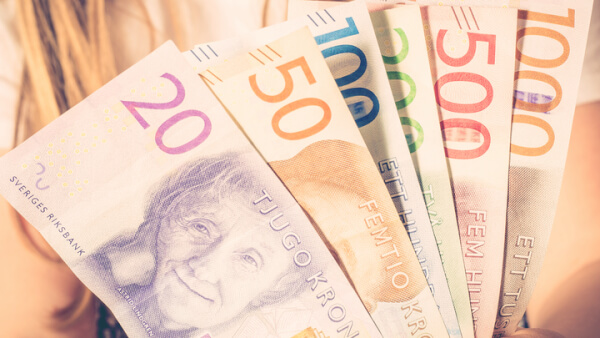VAT refund in Sweden: A complete guide to tax-free shopping in Sweden for tourists
Discover how to claim your VAT refund in Sweden with our comprehensive guide. Learn about Sweden’s VAT refund process for getting your refund.

Sweden is certainly cool - both in terms of the climate, and the city vibe. Hit Stockholm or Gothenburg for your cultural fix, sail, kayak or feast on crayfish along the stunning coast, or head out into the vast, and unspoiled rural north if that’s more your thing.
If you have a trip to Sweden coming up soon - or if you’re planning a long term stay, to work or study - you will need some cash to pay for things while you’re there. Getting what you need from ATMs once you arrive is a convenient choice for many travellers and expats - and means you never have to carry too much cash around as you travel.
If you’re planning on using ATMs in Sweden, here’s all you need to know.
Sweden is a country where credit and debit cards are used frequently - more so than cash in many cities and towns. Even small stores and kiosks will take a card payment, meaning that you don’t necessarily need to carry around a huge amount of local cash if you’re sticking to the cities. All that said, if you’re planning a trip into the more rural areas then cash will be essential - luckily ATMs are usually easy enough to find.
To find a convenient ATM wherever in Sweden you happen to be, use these ATM locators for both local and global banks:
Visa and Mastercard are widely accepted in Sweden. Discover cards have ‘moderate’ merchant acceptance - meaning they are taken by some stores and restaurants but not others.¹ Discover and Amex cards can both be used in Bankomat ATMs, which is handy as this is a large ATM network in Sweden.²
Find a convenient ATM to suit your needs using one of the following locators:
To use your credit or debit card in Sweden you’ll need a 4 digit PIN. Longer 5 or 6 digit PINs issued elsewhere in the world might not work in Swedish ATMs.³
If you typically use a card without a PIN, like an American-issued magnetic stripe card, you’ll need to request a 4 digit PIN for the card from your bank before you travel if you want to get cash from Swedish ATMs.
How much you can withdraw from a Swedish ATM will depend in part on the rules of your own home account, and that of the specific Swedish ATM operator. If you have a maximum cash withdrawal amount set by your home bank for local use, this will apply when you travel, too.
However, there is no official or legal limit on the amount of cash you can withdraw from an ATM in Sweden, on a daily or per-transaction basis. That means that different banks set their own rules and upper limits. If you don’t usually have a maximum cash withdrawal limit on your account then the ATM provider’s rules will apply instead.
Before you travel it’s worth letting your bank know your plans. Usually, this is easy enough to do, with an online form, or simply by calling into a branch. If you don’t tell them that you will be using your bank card abroad, then the fraud department might suspect criminal activity or theft, and block or limit the account. That means you won’t be able to use your credit or debit card - in ATMs, or anywhere else for that matter - until you talk to your bank to let them know it’s you using your card overseas. And that’s a hassle nobody wants to deal with during a holiday.
There’s a good chance that if you’re planning on using a foreign debit or credit card in Sweden, you’ll have to pay a fee to withdraw cash from ATMs there.
Don’t pay more than you have to. Here are the fees - and scams - to watch out for.
Dynamic currency conversion (also called DCC) - is one of the biggest unnecessary costs that travellers face when using a credit or debit card abroad. DCC is where you’re offered the choice of paying for a transaction or cash withdrawal in your home currency instead of the local one.
It’s sold as a handy service, which means that travellers don’t have to navigate a new and confusing currency. However, DCC doesn’t offer a good value for customers. The exchange rate used is often not the real, mid-market rate, which you’d find on google. Instead, if you opt to pay in your home currency, you give the merchant permission to choose the exchange rate applied - and they usually mark up the rate and pocket the difference. You’ll get a better deal if you always choose to pay in the local currency instead.
Don’t get a nasty surprise. Most banks charge their own customers when they use ATMs overseas. These costs can be fixed, or a percentage of the amount withdrawn - and can quickly mount up. Check out the charges added to international ATM withdrawals for your specific account before you travel.
Some banks in Sweden charge a fee to use an international card in their ATMs. These charges vary and are set by the individual bank. Most ATMs include an option to allow you to carry out your transaction in English and should show the fee being added by the ATM before you hit confirm. If you’re unhappy with the fee you can cancel the transaction and try another ATM nearby.
It’s helpful to know that Bankomat networked ATMs don’t add a fee - although you could still be charged by your own bank for international card use.⁴
If you have an account with one of the large banks in Sweden which also operate elsewhere in the region, then you might be able to avoid ATM fees by sticking to ATMs in your own network. If not, ask your home bank if they have a partner institution based in Sweden. Often banks work together and offer their customers free or reduced fee cash withdrawals, from specific ATMs overseas. Check it out before you travel, to make sure you get the best deal.
Even if you can’t get rid of fees altogether, you can reduce ATM fees in Sweden with a few simple tricks.
As international ATM withdrawal fees vary widely between different account types, it’s worth checking out how to get the best deal for overseas cash withdrawals if you have more than one credit or debit card. Simply choose the card you hold with the lowest fees and stick to that while you travel - or you might even consider opening a new account specifically for travel, with a bank which offers a good deal on overseas cash withdrawals.
Don’t get caught out by DCC. Choosing to pay in your home currency just makes the transaction more expensive overall. Avoid unnecessary costs by choosing to pay in the local currency, at ATMs, stores and restaurants. Here is also a list of the European countries that charge the highest ATM fees.
Another option is to transfer cash in advance to a local bank account, and then withdraw what you need from the local account using fee-free ATMs, when you need it. You can do this if you have a local bank account in Sweden, or if you know someone who does. And if you use Wise to make your international money transfer, you might be able to save even more. Wise only uses the real, mid-market exchange rate for transfers, with just a small fee per transaction. And that means more to spend during your trip to Sweden.
If you travel frequently, you might be even better off with a borderless multi-currency account from Wise. You can keep your cash in any one of dozens of different currencies, and there’s no fee charged for operating your account. You can also get a linked debit card for extra convenience.
Life in Sweden isn’t cheap - so the last thing you want is to get ripped off on currency exchange, or excessive ATM fees. Luckily, as long as you’re careful about DCC, you can often keep fees down to a minimum, and the exchange rates offered by ATMs are usually fair. Or, why not give Wise a try. Send money to a local account, and avoid international ATM fees altogether.
Sources:
¹https://www.discover.com/credit-cards/help-center/account/international-use.html (March 6 2018)
²https://network.americanexpress.com/globalnetwork/atm_locator/en/#search/60.12816100000001/18.643501000000015 (March 6 2018)
³https://thesavvybackpacker.com/using-money-in-europe-atms-credit-cards-debit-cards-exchange-rates-currency-confusion-and-more/ (March 6 2018)
⁴https://bankomat.se/kundservice/#vad-kostar-det-att-gora-ett-uttag-eller-en-insattning (March 6 2018)
This publication is provided for general information purposes only and is not intended to cover every aspect of the topics with which it deals. It is not intended to amount to advice on which you should rely. You must obtain professional or specialist advice before taking, or refraining from, any action on the basis of the content in this publication. The information in this publication does not constitute legal, tax or other professional advice from TransferWise Limited or its affiliates. Prior results do not guarantee a similar outcome. We make no representations, warranties or guarantees, whether express or implied, that the content in the publication is accurate, complete or up to date.
*Please see terms of use and product availability for your region or visit Wise fees and pricing for the most up to date pricing and fee information.
This publication is provided for general information purposes and does not constitute legal, tax or other professional advice from Wise Payments Limited or its subsidiaries and its affiliates, and it is not intended as a substitute for obtaining advice from a financial advisor or any other professional.
We make no representations, warranties or guarantees, whether expressed or implied, that the content in the publication is accurate, complete or up to date.

Discover how to claim your VAT refund in Sweden with our comprehensive guide. Learn about Sweden’s VAT refund process for getting your refund.

Should you pay with cash or card in Sweden? A handy guide including cash etiquette, Swedish ATMs and using your UK card.

Stockholm is the wonderfully cultural capital city of Sweden. If you’re planning a trip to Stockholm, you’ll be wanting to convert some cash to enjoy what the...

Sweden is a beautiful northern country not only known for its peaceful nature, but for its out-of the box ideas. Take, for example, the fact that Sweden was...